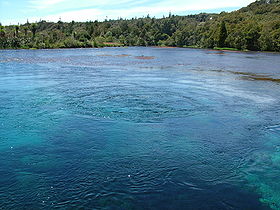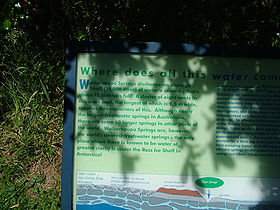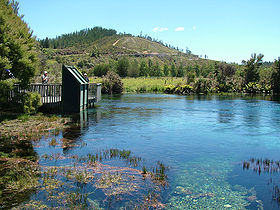
Te Waikoropupu Springs
Encyclopedia

Golden Bay
Golden Bay lies at the edge of the junction between the Tasman Sea and Cook Strait. It stretches for 45 kilometres from the long sand spit of Farewell Spit in the north to Separation Point in Abel Tasman National Park at its southern extremity...
, on New Zealand's
New Zealand
New Zealand is an island country in the south-western Pacific Ocean comprising two main landmasses and numerous smaller islands. The country is situated some east of Australia across the Tasman Sea, and roughly south of the Pacific island nations of New Caledonia, Fiji, and Tonga...
South Island
South Island
The South Island is the larger of the two major islands of New Zealand, the other being the more populous North Island. It is bordered to the north by Cook Strait, to the west by the Tasman Sea, to the south and east by the Pacific Ocean...
. The springs are known for the clarity of the water, and the volume of water discharged. The springs are spiritually significant to the Māori people.
Water clarity
The horizontal visibility of the water in the springs has been measured at an average of 63 metres, a world record for fresh water. This value, which was verified using specialist optical instruments, approaches the theoretical maximum for optically pure water.(See www.rsnz.org/publish/nzjmfr/1995/65.pdf)
Volume of water

Boston
Boston is the capital of and largest city in Massachusetts, and is one of the oldest cities in the United States. The largest city in New England, Boston is regarded as the unofficial "Capital of New England" for its economic and cultural impact on the entire New England region. The city proper had...
, Massachusetts
Massachusetts
The Commonwealth of Massachusetts is a state in the New England region of the northeastern United States of America. It is bordered by Rhode Island and Connecticut to the south, New York to the west, and Vermont and New Hampshire to the north; at its east lies the Atlantic Ocean. As of the 2010...
. The floor of the lake is covered with white sand. Waters expelled from some of the smaller vents carry the sand upward. These vents are known as the 'dancing sands', which for the few scuba divers who have secured permission to dive in the springs, is one of the highlights of underwater sightseeing.
Spiritual significance

Tapu
Tapu, tabu or kapu is a Polynesian traditional concept denoting something holy or sacred, with "spiritual restriction" or "implied prohibition"; it involves rules and prohibitions...
with the Māori Heritage Council of the New Zealand Historic Places Trust
New Zealand Historic Places Trust
The New Zealand Historic Places Trust is a non-profit trust that advocates for the protection of ancestral sites and heritage buildings in New Zealand...
.
Waikoropupu is the legendary home of the female taniwha
Taniwha
In Māori mythology, taniwha are beings that live in deep pools in rivers, dark caves, or in the sea, especially in places with dangerous currents or deceptive breakers...
, Huriawa, one of the three main taniwha of Aotearoa
Aotearoa
Aotearoa is the most widely known and accepted Māori name for New Zealand. It is used by both Māori and non-Māori, and is becoming increasingly widespread in the bilingual names of national organisations, such as the National Library of New Zealand / Te Puna Mātauranga o Aotearoa.-Translation:The...
. She is a diver of land and sea, travelling deep beneath the earth to clear blocked waterways. She is brave and wise and believed to still rest in the waters of Waikoropupu, when she is not away attending to business.
At the entrance to the walkway to the springs, the Department of Conservation
New Zealand Department of Conservation
The Department of Conservation , commonly known by its acronym, "DOC", is the state sector organisation which deals with the conservation of New Zealand’s natural and historic heritage...
has placed a sign:
"Te Waikoropupu Springs are a taonga (treasure) and waahi tapu (a sacred place) for Māori, both locally and nationally. The legends of Te Waikoropupu are told in the stories of Huriawa, its taniwha (guardian spirit). In Māori tradition the Springs are wairou, the purest form of water which is the wairua (spiritual) and the physical source of life. The Springs provide water for healing, and in the past were a place of ceremonial blessings at times of birth and death and the leaving and returning of travellers."

